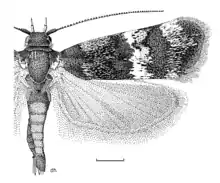Hierodoris polita
Hierodoris polita is a species of moth in the family Oecophoridae. It is endemic to New Zealand. This species is classified as "At Risk, Naturally Uncommon" by the Department of Conservation.
| Hierodoris polita | |
|---|---|
 | |
| Scientific classification | |
| Kingdom: | |
| Phylum: | |
| Class: | |
| Order: | |
| Family: | |
| Genus: | |
| Species: | H. polita |
| Binomial name | |
| Hierodoris polita Hoare, 2005[1] | |
Taxonomy
This species was first described by Robert J. B. Hoare in 2005 and named Hierodoris polita.[1] Prior to its scientific description H. polita was known as H. ‘silver banded’.[2] The holotype specimen, which was collected by John S. Dugdale at Craig Flat, Clutha Valley on 16 March 1986, is held at the New Zealand Arthropod Collection.[2]
Description
The wingspan of the male of the species is between 11-14.5 mm and the female is between 12.5-13.5 mm.[2]
H. polita is very similar in appearance to its close relatives Hierodoris frigida and H. extensilis.[3] It can be distinguished from H. frigida as H. polita lacks the all-yellow segment 2 of the labial palp as well as the yellowish white spot that H. frigida has on its costa.[2] H. polita has white scales on the posterior part of the tegulae where as H. frigida has a dark tegulae.[2] H. polita also has a white transverse band on the forewing that H. frigida lacks.[2]
H. polita can be distinguished from H. extensilis as the later has a white base to the hindwing whereas H. polita has a bronzy base.[3] The exterior surface of the labial palpi of H. extensilis is white-scaled whereas H. polita is dark-scaled.[3] H. polita also has a transverse white forewing fascia which both H. extensilis and H. frigida lack.[3]
Distribution
This species is endemic to New Zealand.[1][4] It can only be found in the South Island in the Central Otago and Dunedin areas.[2] H. polita is classified as range restricted indicating its local distribution.[5]
Biology and behaviour
Although larvae of this species have not been conclusively identified, a likely specimen was collected in leaf litter consisting of detritus of Grimmia laevigata.[2] It has therefore been hypothesised that the larvae of H. polita is a detritivore.[2] The species has been found on the wing in October, November, and January to March.[2]
Habitat and host species
This species is known to prefer open habitat and has so far mainly been collected at south-facing rocky bluffs upon which grow species of Grimmia moss.[2]
Conservation Status
This species has been classified as having the "At Risk, Naturally Uncommon" conservation status under the New Zealand Threat Classification System.[5]
References
| Wikimedia Commons has media related to Hierodoris polita. |
| Wikispecies has information related to Hierodoris polita. |
- "Hierodoris polita Hoare, 2005". www.nzor.org.nz. Landcare Research New Zealand Ltd. Retrieved 23 May 2018.
- Hoare, R. J. B. (2005). "Hierodoris (Insecta: Lepidoptera: Gelechioidea: Oecophoridae), and overview of Oecophoridae" (PDF). Fauna of New Zealand. 54: 1–102. ISBN 0478093780.
- Hoare, R. J. B. (March 2012). "A new species of Hierodoris Meyrick (Lepidoptera: Oecophoridae) with a telescopic ovipositor, from granite sand plains in Fiordland". New Zealand Entomologist. 35 (1): 51–57. doi:10.1080/00779962.2012.651776.(subscription required)
- Gordon, Dennis P., ed. (2010). New Zealand inventory of biodiversity. Volume two. Kingdom animalia : chaetognatha, ecdysozoa, ichnofossils. Vol. 2. Christchurch, N.Z.: Canterbury University Press. p. 462. ISBN 9781877257933. OCLC 973607714.
- Hoare, R.J.B.; Dugdale, J.S.; Edwards, E.D.; Gibbs, G.W.; Patrick, B.H.; Hitchmough, R.A.; Rolfe, J.R. (2017). "Conservation status of New Zealand butterflies and moths (Lepidoptera), 2015" (PDF). New Zealand Threat Classification Series. 20: 8.